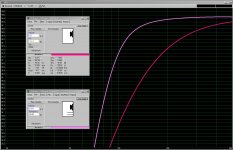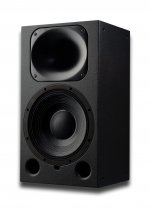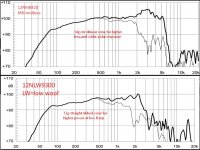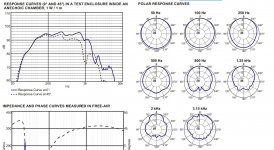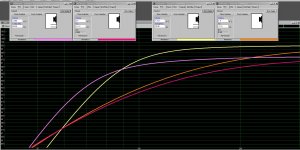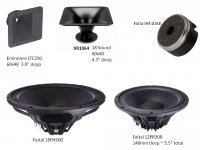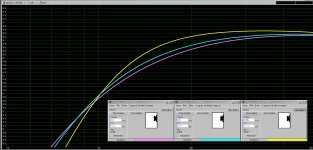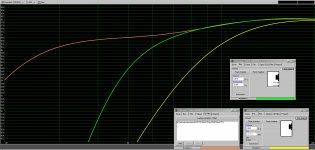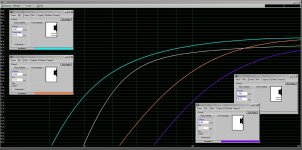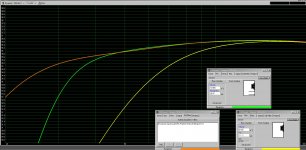Hi all
So I'm new here and to te world of DIY speakers.
I'm considering a build based on the 18 sound XT1086/BMS4538 CD horn combo with a yet unchosen 12" woofer.
I'm aiming to but this in a ported cabinet of around 1.5cubic feet, it needs to play down to around 80hz if possible.
Ideally I would prefer a 4 ohm driver but I'm open to options.
Any thoughts on driver choice? Also when looking for drivers would a driver with a FR of say up to 1500hz be too low? I'm guessing these kinds of drivers are aimed for 3-way systems.
As I'm base in Europe I would prefer a European manufacturer.
Also this is to be used in a dedicated home cinema... If that influences driver choice 🙂.
Thanks in advance.
So I'm new here and to te world of DIY speakers.
I'm considering a build based on the 18 sound XT1086/BMS4538 CD horn combo with a yet unchosen 12" woofer.
I'm aiming to but this in a ported cabinet of around 1.5cubic feet, it needs to play down to around 80hz if possible.
Ideally I would prefer a 4 ohm driver but I'm open to options.
Any thoughts on driver choice? Also when looking for drivers would a driver with a FR of say up to 1500hz be too low? I'm guessing these kinds of drivers are aimed for 3-way systems.
As I'm base in Europe I would prefer a European manufacturer.
Also this is to be used in a dedicated home cinema... If that influences driver choice 🙂.
Thanks in advance.
It sounds like you want a pro driver. A paper cone and pleated surround can aid in reaching high smoothly, and with efficiency. This kind of design will call for the woofer going to around the upper limit for a 12" driver.
You want DA BOOM-BOOM-BOOM for home theater, plus precision and detail for critical listening, plus >94db/watt. You need a 3-way design.
18 Sound 12NMB420 is a 99db/watt efficient midbass, with a very low 34g Mms, and a very low 0.2mH inductance. ~ 170 - 200 Euros quick check.
You will get the best sound in a 1.5 cu ft, well stuffed, sealed box. -6db for LR4 Xover at 90Hz with Qtc ~0.5 for well controlled transients. You cannot get the best midrange sound from a ported box.
A 15" or 18" high efficiency woofer can be big-box-ported for a passive Xover, or small-box-sealed for an equalized active Xover.
The 18Sound XT1086 has a diffraction aperture at the throat that flattens out the response in front of the speaker, but the beamwidth is not as consistent(varies more) compared to a "normal" constant directivity horn/waveguide, and the consequence of this is that the lower frequencies on the XT1086 will begin to dominate as you move off axis. With a "normal" constant directivity horn/waveguide the response falls off more consistently as you go off-axis, so the timbre of sounds remains consistent and just gets quieter.
Staying with 18 Sound, consider the XR1064 60° x 40° horizontal and vertical constant coverage horn with ~1400Hz LR4 Xover. You want the 12" midbass to have a 60 degree beaming at the Xover frequency to match this horn, and will need some measurements since the datasheet plots look close but are not detailed. The XR1064 is about 4.3" deep, and this will give a "close" physical time alignment between compression-dome and 12" midbass coil. Physically butt the horn to the speaker to minimize C-to-C comb filter problems.
Using a popular 90x40 SEOS waveguide would require ~ 1100 Hz LR4 xover for the 12" midbass polar response to match 90 degree waveguide. You will need to decide between wider BW vs. wider polar dispersion.
Staying with 18 Sound for the 1" compression driver tweeter will assure that the horn entry angle matches the compression driver. Let your budget and ears(metal vs plastic diaphragm) decide. A B&C DE250 plastic dome 1" compression deiver is a well reviewied low cost option(14 degree entry angle) THe BMS4538 CD also has a 14 degree entry angle, and would be an excellent tweeter.
HD1040 Treated polyethylene diaphragm $ 100 Euros
ND1090 Titanium dome over PEN suspension $$
NSD1095N True Piston Motion TiN coated titanium diaphragm $$$
18 Sound 12NMB420 is a 99db/watt efficient midbass, with a very low 34g Mms, and a very low 0.2mH inductance. ~ 170 - 200 Euros quick check.
You will get the best sound in a 1.5 cu ft, well stuffed, sealed box. -6db for LR4 Xover at 90Hz with Qtc ~0.5 for well controlled transients. You cannot get the best midrange sound from a ported box.
A 15" or 18" high efficiency woofer can be big-box-ported for a passive Xover, or small-box-sealed for an equalized active Xover.
The 18Sound XT1086 has a diffraction aperture at the throat that flattens out the response in front of the speaker, but the beamwidth is not as consistent(varies more) compared to a "normal" constant directivity horn/waveguide, and the consequence of this is that the lower frequencies on the XT1086 will begin to dominate as you move off axis. With a "normal" constant directivity horn/waveguide the response falls off more consistently as you go off-axis, so the timbre of sounds remains consistent and just gets quieter.
Staying with 18 Sound, consider the XR1064 60° x 40° horizontal and vertical constant coverage horn with ~1400Hz LR4 Xover. You want the 12" midbass to have a 60 degree beaming at the Xover frequency to match this horn, and will need some measurements since the datasheet plots look close but are not detailed. The XR1064 is about 4.3" deep, and this will give a "close" physical time alignment between compression-dome and 12" midbass coil. Physically butt the horn to the speaker to minimize C-to-C comb filter problems.
Using a popular 90x40 SEOS waveguide would require ~ 1100 Hz LR4 xover for the 12" midbass polar response to match 90 degree waveguide. You will need to decide between wider BW vs. wider polar dispersion.
Staying with 18 Sound for the 1" compression driver tweeter will assure that the horn entry angle matches the compression driver. Let your budget and ears(metal vs plastic diaphragm) decide. A B&C DE250 plastic dome 1" compression deiver is a well reviewied low cost option(14 degree entry angle) THe BMS4538 CD also has a 14 degree entry angle, and would be an excellent tweeter.
HD1040 Treated polyethylene diaphragm $ 100 Euros
ND1090 Titanium dome over PEN suspension $$
NSD1095N True Piston Motion TiN coated titanium diaphragm $$$
Attachments
Last edited:
Excellent reply.
Thank you 🙂.
I will look into this later on when I'm in from work.
Any suggestions for a design to cover 20hz to 80/90hz?
I guess something ported with a tuning frequency of around 20hz.. And ideally a 15" woofer?
Thank you 🙂.
I will look into this later on when I'm in from work.
Any suggestions for a design to cover 20hz to 80/90hz?
I guess something ported with a tuning frequency of around 20hz.. And ideally a 15" woofer?
Still learning here so forgive me,
But how would a driver such as this fair paired with the BMS horn combo?
12NLW9300 - LF Neodymium Driver
But how would a driver such as this fair paired with the BMS horn combo?
12NLW9300 - LF Neodymium Driver
Don't want to appear as I'm talking to myself but some googling shows up these as being rather special with home theatre, replicating these sounds like a challenge...
Specs as follows
> Professional 12-inch, 1400W woofer with 4-inch voice coil
> Professional 1-inch compression driver on elliptical constant directivity horn
> High frequency extension to beyond 30kHz
> High sensitivity: 93dB LF; 114dB HF
> Maximum output >130dB
> Designed for placement behind acoustically transparent screen
> Only 12-inches deep
> 8th order crossover slopes
> 4-ohm nominal impedance LF; 8-ohms HF
Application: Bi-amplified medium format screen channel loudspeaker
LF Section: 12” professional grade woofer with 4” voice coil
HF Section: 1” professional-grade compression driver / polyester diaphragm
80° x 60° elliptical horn
Crossover: 8th order acoustic via DSP
Power Handling: 1400W LF / 120W HF
Sensitivity: 93dB LF / 114dB
Power Requirements: Requires bi-amplification via PRO power amplifier
Frequency Range: 54Hz – 31kHz
Maximum Output: >130dB
Nominal Impedance: 4-ohms
Dimensions: 25” H x 14” W x 12”D
Weight: 62 lbs.
A picture, anyone recognise the woofer?
Specs as follows
> Professional 12-inch, 1400W woofer with 4-inch voice coil
> Professional 1-inch compression driver on elliptical constant directivity horn
> High frequency extension to beyond 30kHz
> High sensitivity: 93dB LF; 114dB HF
> Maximum output >130dB
> Designed for placement behind acoustically transparent screen
> Only 12-inches deep
> 8th order crossover slopes
> 4-ohm nominal impedance LF; 8-ohms HF
Application: Bi-amplified medium format screen channel loudspeaker
LF Section: 12” professional grade woofer with 4” voice coil
HF Section: 1” professional-grade compression driver / polyester diaphragm
80° x 60° elliptical horn
Crossover: 8th order acoustic via DSP
Power Handling: 1400W LF / 120W HF
Sensitivity: 93dB LF / 114dB
Power Requirements: Requires bi-amplification via PRO power amplifier
Frequency Range: 54Hz – 31kHz
Maximum Output: >130dB
Nominal Impedance: 4-ohms
Dimensions: 25” H x 14” W x 12”D
Weight: 62 lbs.
A picture, anyone recognise the woofer?
Attachments
For home audio, a 12" midbass is usually selected to obtain very high efficiency over a wide bandwidth because a good 12" midbass can still be mated to a 1" compression driver that reaches 20Khz. There are several 12" speakers which can provide ~95db/watt, and a few which can provide a very dynamic ~98db/watt that tube lovers pursue.
The American made 96db/watt Lambda TD12M is the lowest distortion, best SPL curve, best polar response, true midbass that I have found. Expensive in EU, but a very good reference to study for comparison shopping. There are many great 12" midbass that have been studied for EconoWave designs with the 90x40 SEOS12 waveguide with ~1100-1200Hz Xover. Eminence Deltalite 2512 and Kapalite 3012HO are popular and have Xover designs available.
18Sound makes several 12" speakers to cover the market, including:
12NMB420 curvilinear smooth cone 34g Mms low'ish power "true midbass"
12ND930 curvilinear smooth cone 56g Mms higher power midbass "jack of all trades"
12LW9300 straight ribbed cone 72g Mms higher power woof-mid
The 12NMB420 or 12ND930 are more of a midbass design than the 12LW9300.
"I guess something ported with a tuning frequency of around 20hz.. And ideally a 15" woofer? " This will be a BIG box, which could allow a single amp, all passive Xover design option. Adjusting the ports, plus near-wall placement allows some room equalization. When you include baffle step compensation, the woofer will not be as efficient as the midbass, which will drag down a single amp speaker's efficiency. An active equalized sealed box would be smaller, even with an 18" woofer. A sealed box can "potentially" deliver superior transient response, plus lower group delay, plus better phase response, plus active room equalization.
Some woofer design decisions include:
---single amp vs. bi-amp
---all passive Xover vs. all active Xover vs. active bass + passive mid-tweet Xover
---large ported bass cabinet vs. smaller sealed bass cabinet with active equalization
The American made 96db/watt Lambda TD12M is the lowest distortion, best SPL curve, best polar response, true midbass that I have found. Expensive in EU, but a very good reference to study for comparison shopping. There are many great 12" midbass that have been studied for EconoWave designs with the 90x40 SEOS12 waveguide with ~1100-1200Hz Xover. Eminence Deltalite 2512 and Kapalite 3012HO are popular and have Xover designs available.
18Sound makes several 12" speakers to cover the market, including:
12NMB420 curvilinear smooth cone 34g Mms low'ish power "true midbass"
12ND930 curvilinear smooth cone 56g Mms higher power midbass "jack of all trades"
12LW9300 straight ribbed cone 72g Mms higher power woof-mid
The 12NMB420 or 12ND930 are more of a midbass design than the 12LW9300.
"I guess something ported with a tuning frequency of around 20hz.. And ideally a 15" woofer? " This will be a BIG box, which could allow a single amp, all passive Xover design option. Adjusting the ports, plus near-wall placement allows some room equalization. When you include baffle step compensation, the woofer will not be as efficient as the midbass, which will drag down a single amp speaker's efficiency. An active equalized sealed box would be smaller, even with an 18" woofer. A sealed box can "potentially" deliver superior transient response, plus lower group delay, plus better phase response, plus active room equalization.
Some woofer design decisions include:
---single amp vs. bi-amp
---all passive Xover vs. all active Xover vs. active bass + passive mid-tweet Xover
---large ported bass cabinet vs. smaller sealed bass cabinet with active equalization
Attachments
Thanks for another great reply.
I would be looking at a 2 way design using a 12" with the 18 Sound / BMS combo.
This will be powered by 2 amplifier channels per speaker, the crossover is an active one limited to LW.
Ideally the 2 way will be good down to 80hz (the traditional crossover frequency for home theatre).
How would the Beyma 12P80Nd in my situation? I've seen nothing but kind words on that driver.
It looks like I may have more research to do before taking the plunge with this one...
The TDM12 looks a brilliant driver but unfortunately for us european souls its not an option, same with the SEOS waveguides, again out of reach for us 🙁.
I would be looking at a 2 way design using a 12" with the 18 Sound / BMS combo.
This will be powered by 2 amplifier channels per speaker, the crossover is an active one limited to LW.
Ideally the 2 way will be good down to 80hz (the traditional crossover frequency for home theatre).
How would the Beyma 12P80Nd in my situation? I've seen nothing but kind words on that driver.
It looks like I may have more research to do before taking the plunge with this one...
The TDM12 looks a brilliant driver but unfortunately for us european souls its not an option, same with the SEOS waveguides, again out of reach for us 🙁.
WHY TWO WAY ?
High,
two ways seems easier, just two drivers, less filters... but think IMHO it's a harder way.
The crossover between the bass and the mid is difficult, easy to go under 300 hz with 3 ways. With 2 ways you have to deal with the bass load and the mid bass cross over...not easy!
If you want two ways, you need something like horn with something between 400 & 700 hz crossover or a planar like esl or wide band magnet planar like B&G 75. My opinion is each are difficult to set up and you spend a lot of time whitout enjoy music!
My 5 cents advise :
1) have a brand speaker to enjoy music before go DIY
2) with DIY go with electronic crossover & measurement because blind passive set up is a long time road (with a commertcial floorstander...with a diy, it's longer !)
3) 3 ways is less expensive with ther final result but special 2 ways design (Stigerik e.g., but don't hear; with horns you can spend one life before have result).
just my own experience...
High,
two ways seems easier, just two drivers, less filters... but think IMHO it's a harder way.
The crossover between the bass and the mid is difficult, easy to go under 300 hz with 3 ways. With 2 ways you have to deal with the bass load and the mid bass cross over...not easy!
If you want two ways, you need something like horn with something between 400 & 700 hz crossover or a planar like esl or wide band magnet planar like B&G 75. My opinion is each are difficult to set up and you spend a lot of time whitout enjoy music!
My 5 cents advise :
1) have a brand speaker to enjoy music before go DIY
2) with DIY go with electronic crossover & measurement because blind passive set up is a long time road (with a commertcial floorstander...with a diy, it's longer !)
3) 3 ways is less expensive with ther final result but special 2 ways design (Stigerik e.g., but don't hear; with horns you can spend one life before have result).
just my own experience...
?? Anyone using the BMS 4538 around 1200-1400Hz?
The 1" exit BMS 4538 compression driver you discussed has a 1.5" diameter diaphragm, instead of the more common 1.75". This allows good high frequency extenstion, but a 1900Hz min Xover is recommended. The BMS 4550 with a 1.75" diaphragm is the normal choice for low'ish crossover frequencies like the 1.2-1.4Khz needed to the 12" midbass. The 4550 is thin and this helps physical time alignent. The B&C DE250 is also a very common recommendation. One example 12" polar plot shows 1.2-1.4Khz freq where 60 degree horn blends in.
The WinISD plot shows Qtc=0.5 sealed and Qtc=0.7 ported SPL simulations for the Eminence KappaLite 3012HO and 18Sound 12NMB420. Superior transients from a sealed box has less bass extension than a ported box. Higher efficiency 12NMB420 has less bass extension than 3012HO.
Worth some simulation.
18Sound 12NMB420 or Eminence 30212HO
18Sound XR1064 60x40 constant directivity Aluminum horn
BMS 4550 1" compression driver
18" woofer usable in sealed/equalized or ported like BMS 18N830v1, Beyma 18LX60 rev1, Faital 18FH500. BIG woof needed for your >94db/watt goal.
The Beyma 12P80Nd has a low Qts=0.15 as used with a rear horn design, but also has 7.5mm of Xmax with very low harmonic distortion as required in a bass reflex woofer. This speaker can allow a very tight high frequency transient response from the Qts=0.15 in a large sealed box, plus continued low Qts control down into the 80Hz bass range from electronic equalization. For your ears only.
The 1" exit BMS 4538 compression driver you discussed has a 1.5" diameter diaphragm, instead of the more common 1.75". This allows good high frequency extenstion, but a 1900Hz min Xover is recommended. The BMS 4550 with a 1.75" diaphragm is the normal choice for low'ish crossover frequencies like the 1.2-1.4Khz needed to the 12" midbass. The 4550 is thin and this helps physical time alignent. The B&C DE250 is also a very common recommendation. One example 12" polar plot shows 1.2-1.4Khz freq where 60 degree horn blends in.
The WinISD plot shows Qtc=0.5 sealed and Qtc=0.7 ported SPL simulations for the Eminence KappaLite 3012HO and 18Sound 12NMB420. Superior transients from a sealed box has less bass extension than a ported box. Higher efficiency 12NMB420 has less bass extension than 3012HO.
Worth some simulation.
18Sound 12NMB420 or Eminence 30212HO
18Sound XR1064 60x40 constant directivity Aluminum horn
BMS 4550 1" compression driver
18" woofer usable in sealed/equalized or ported like BMS 18N830v1, Beyma 18LX60 rev1, Faital 18FH500. BIG woof needed for your >94db/watt goal.
The Beyma 12P80Nd has a low Qts=0.15 as used with a rear horn design, but also has 7.5mm of Xmax with very low harmonic distortion as required in a bass reflex woofer. This speaker can allow a very tight high frequency transient response from the Qts=0.15 in a large sealed box, plus continued low Qts control down into the 80Hz bass range from electronic equalization. For your ears only.
Attachments
Thanks again for another good reply.
This guy used a BMS with the XT1086,
http://www.diyaudio.com/forums/swap...waveguides-bms-4538-compression-tweeters.html
But the 4550 doesn't cost much more over here.
As for the 12" options the 18 sound is appealing at the moment, but I will continue to search.
Do BMS have a suitable 12"?
How about other brands such as Volt? Or faital pro? All of which can be had reasonable cheap.
And finally one more question, which may be a stupid one....
Would it be possible to use a low bass rather than a mid bass if the crossover was going to be around 1400/1500hz? The BMS 12N804 for example?
Thanks again
This guy used a BMS with the XT1086,
http://www.diyaudio.com/forums/swap...waveguides-bms-4538-compression-tweeters.html
But the 4550 doesn't cost much more over here.
As for the 12" options the 18 sound is appealing at the moment, but I will continue to search.
Do BMS have a suitable 12"?
How about other brands such as Volt? Or faital pro? All of which can be had reasonable cheap.
And finally one more question, which may be a stupid one....
Would it be possible to use a low bass rather than a mid bass if the crossover was going to be around 1400/1500hz? The BMS 12N804 for example?
Thanks again
1. How about other brands such as faital pro? which can be had reasonable cheap.
2. This guy used a BMS with the XT1086,
3)Would it be possible to use a low bass ... the BMS 12N804 for example?
1) If you can get good prices on Italian Faital, the 12PR300 is a good midbass.(in my table)
FAITAL ATTRACTION:
12PR300 12" mid
18FH500 18" woof
HF10AK 1" compression - very good at 1.2-1.6Khz Xover freqs
HORNS.... study physical depth and polar response of several horns to match your midbass at your selected Xover frequency. A 60 x 40 horn polar is usually a good match to a 12" midbass with 1200-1600Hz Xover. A shallow horn is needed for simple physical time alignment between the tweeter and midbass delays. Send a square wave to the midbass and tweeter mounted on a flat baffle(even cardboord box) and watch the mic signal on an O'scope for time alignment.
Common 60 x 40 horns:
a) 18Sound XR1064 1.2-1.6Khz Xover freqs or
b) Eminence LTC250 1.2-1.6Khz Xover freqs or
c) QSC waveguide at 1,100Hz Xover(pictures and Xovers on web) or
d) study and model further
The STH100 Faital Tractix horn is an attractive 3.4" deep, but it has an 80x70 polar response that has home audio crossover challenges. The 80 degree horizontal polar requires a slightly undesirably low Xover frequency from a 12" midbass. The 70 degree vertical polar puts too much room ground bounce effects to be optimal for a home application. A 40 degree vertical polar is often considered better for home listening because it removes significant floor/ceiling bounce.
2) That BMS 4538 design uses a 8" true midrange which allows a Xover over 2.4Khz which the 4538 can easily handle. The BMS 4550 is designed for lower Xover freqs.
3) If you look over the BMS 12N804 SPL vs. freq spec it shows that the heavy, flat, ribbed, cone struggles to even reach 1000Hz(big dip). If you are building a 3-way speaker, it is desirable to use a true midbass for the best possible sound. As discussed earler: curvilinear cone; low Mms, low Le, flat and well extended SPL vs. freq plot up to 2-3Khz, wide polar response above 1Khz, etc..
Attachments
Thanks again, you have been a great help so far.
How do you rate the RCF H100? It looks good, is a good price and appears to play quite low?
I would pair this with the BMS 4550 CD (I've decided to stick with BMS as I have heard the 4538 and it sounded great to my ears).
As for the woofer I think I'm down to a choice of 3,
18 Sound 12NMB420 £145.00
B&C 12HPL76 £184.00
FaitalPRO 12PR300 £125.00
In either a sealed or ported enclosure of around 1.2 cubic feet.
Thoughts? Money isn't really an issue for the right driver.
Remember these are not being built to be musical, I want the boom boom 🙂.
Thanks
How do you rate the RCF H100? It looks good, is a good price and appears to play quite low?
I would pair this with the BMS 4550 CD (I've decided to stick with BMS as I have heard the 4538 and it sounded great to my ears).
As for the woofer I think I'm down to a choice of 3,
18 Sound 12NMB420 £145.00
B&C 12HPL76 £184.00
FaitalPRO 12PR300 £125.00
In either a sealed or ported enclosure of around 1.2 cubic feet.
Thoughts? Money isn't really an issue for the right driver.
Remember these are not being built to be musical, I want the boom boom 🙂.
Thanks
The Faital 12PR300 12" midbass and 18FH500 18" woofer are popular speakers that meet your goals and are worth additional simulation. There are several high quality DIY designs on the web for the 12PR300 that you can study or clone. Faital Pro 12PR300 + SEOS-12/DNA-360
Attached 12PR300 WinISD simulation shows SPL shapes for different volume sealed cabinets that produce popular Qtc of 0.5, 0.577, 0.7 tuning. Some ears like Qtc=0.5 "critically damped" response .some. Qtc=0.577 "maximal flat delay" response .some. Qtc=0.7 "maximum flat amplitude" response.
Attached 18FH500/18FH510 WinISD simulation shows SPL for (1) sealed box. (2) sealed box with Linkwitz Transform equalization down to 20Hz. (3) ported box. Sealed allows smaller box, but needs high power equalization for deep bass.
The two popular home theater horn/waveguide polar response patterns are:
1) 90x40 like the SEOS waveguide since the 90 degree pattern covers a wide listening area. To match the 90 degree waveguide polar response to a 12" woofer requires a ~1100hz crossover frequency which is often considered difficult to perfect.
2) 60x40 removes more side wall effects in exchange for a smaller optimal listening area. Most 12" woofers match a 60 degree horn/waveguide at 1400-1600Hz, which is often considered "good" for 1" compression drivers.
Attached 12PR300 WinISD simulation shows SPL shapes for different volume sealed cabinets that produce popular Qtc of 0.5, 0.577, 0.7 tuning. Some ears like Qtc=0.5 "critically damped" response .some. Qtc=0.577 "maximal flat delay" response .some. Qtc=0.7 "maximum flat amplitude" response.
Attached 18FH500/18FH510 WinISD simulation shows SPL for (1) sealed box. (2) sealed box with Linkwitz Transform equalization down to 20Hz. (3) ported box. Sealed allows smaller box, but needs high power equalization for deep bass.
The two popular home theater horn/waveguide polar response patterns are:
1) 90x40 like the SEOS waveguide since the 90 degree pattern covers a wide listening area. To match the 90 degree waveguide polar response to a 12" woofer requires a ~1100hz crossover frequency which is often considered difficult to perfect.
2) 60x40 removes more side wall effects in exchange for a smaller optimal listening area. Most 12" woofers match a 60 degree horn/waveguide at 1400-1600Hz, which is often considered "good" for 1" compression drivers.
Attachments
Hi
How about the Faital 12PR300 in a vented enclosure? If I plan to cross over to a sub at 80hz is it best to have the F3 at 80hz?
I'm hoping to start buying the bits next week for this build, so I could do with nailing the choices down.
How about the Faital 12PR300 in a vented enclosure? If I plan to cross over to a sub at 80hz is it best to have the F3 at 80hz?
I'm hoping to start buying the bits next week for this build, so I could do with nailing the choices down.
To explore box size vs. bass extension, attached WinISD models Qtc=0.7 sealed and ported boxes for:
Eminence DeltaLite
---Ported 3.5 ft^3, Fs=43Hz
---Sealed 2 ft^3, Fs=86Hz
Faital 12PR300
---Ported 1.75 ft^3, Fs=55Hz
---Sealed 1 ft^3, Fs=103Hz
Sealed midbass cabinets have better transient response than ported. I favor large'ish sealed boxes with on-wall absorption material like Owen 705 fiberglass. Most 3-way designs use a sealed midbass. The Econowave threads debate sealed vs. ported.
Similar Big vs. small box WinISD models for Beyma 18XL60v1 to compare with earlier post of Faital 18FH510. Faital reaches Qtc=0.7 in smaller box with higher F3 than Beyma. More amp eqalization power drives Faital to 20Hz.
BIG ported box with Beyma allows deep bass, and BIG sealed box allows deep bass with modest equalization power.
Small ported box with Faital provides modest bass, and small sealed box allows deep bass only with large equalization power.
The crossover will also need to account for baffle step compensation. At high frequencies the entire wavelength reflects off of the front baffle and all of the driver energy only goes forward(2-PI = 180 degree polar pattern). As the frequency gets lower, the wavelengths get long enough to wrap around the box, and now some of the driver energy goes to the sides and rear, thus reducing the foward energy heard by the listener. A first guess for the baffle step frequency is 4755 / (baffle width inches). Computer simulation gives more accurate results, and the distance to the rear and side wall should also be factored in. 4755 / 18" baffle ~ 265Hz baffle step 2db - 4db is common compensation boost range
You could sketch out and simuate a design before purchase, or copy a completed well reviewed DIY design. Big Decsion:: Selecting between the two popular home theater horn/waveguide polar response patterns:
1) 90x40 like the SEOS waveguide since the 90 degree pattern covers a wide listening area.
2) 60x40 removes more side wall effects in exchange for a smaller optimal listening area.
Eminence DeltaLite
---Ported 3.5 ft^3, Fs=43Hz
---Sealed 2 ft^3, Fs=86Hz
Faital 12PR300
---Ported 1.75 ft^3, Fs=55Hz
---Sealed 1 ft^3, Fs=103Hz
Sealed midbass cabinets have better transient response than ported. I favor large'ish sealed boxes with on-wall absorption material like Owen 705 fiberglass. Most 3-way designs use a sealed midbass. The Econowave threads debate sealed vs. ported.
Similar Big vs. small box WinISD models for Beyma 18XL60v1 to compare with earlier post of Faital 18FH510. Faital reaches Qtc=0.7 in smaller box with higher F3 than Beyma. More amp eqalization power drives Faital to 20Hz.
BIG ported box with Beyma allows deep bass, and BIG sealed box allows deep bass with modest equalization power.
Small ported box with Faital provides modest bass, and small sealed box allows deep bass only with large equalization power.
The crossover will also need to account for baffle step compensation. At high frequencies the entire wavelength reflects off of the front baffle and all of the driver energy only goes forward(2-PI = 180 degree polar pattern). As the frequency gets lower, the wavelengths get long enough to wrap around the box, and now some of the driver energy goes to the sides and rear, thus reducing the foward energy heard by the listener. A first guess for the baffle step frequency is 4755 / (baffle width inches). Computer simulation gives more accurate results, and the distance to the rear and side wall should also be factored in. 4755 / 18" baffle ~ 265Hz baffle step 2db - 4db is common compensation boost range
You could sketch out and simuate a design before purchase, or copy a completed well reviewed DIY design. Big Decsion:: Selecting between the two popular home theater horn/waveguide polar response patterns:
1) 90x40 like the SEOS waveguide since the 90 degree pattern covers a wide listening area.
2) 60x40 removes more side wall effects in exchange for a smaller optimal listening area.
Attachments
Last edited:
- Status
- Not open for further replies.
- Home
- Loudspeakers
- Multi-Way
- Thinking about a 2 way build?

